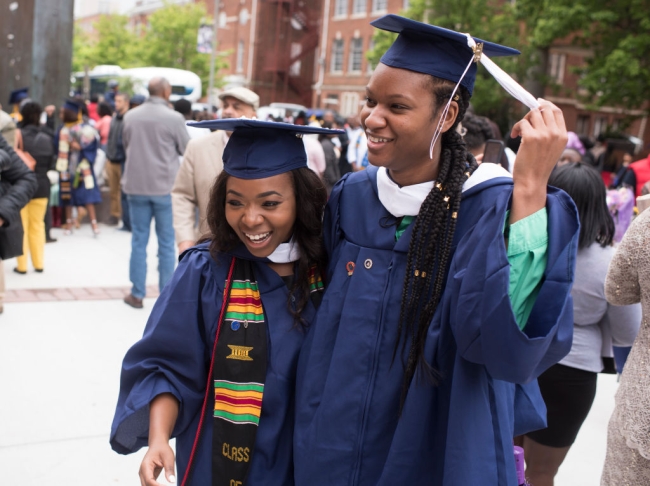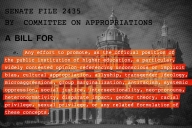You have /5 articles left.
Sign up for a free account or log in.

Graduates of Howard University in Washington, D.C.
The Washington Post via Getty Images
Rises in state-level hate crimes can drive Black students to enroll at historically Black colleges and universities, according to a new study of hate crime and enrollment data. Experts say the findings illustrate the extensive work left to be done at predominantly white colleges to ensure students of color feel safe and welcomed.
The study linked increases in hate crimes reported at the state level to a 20 percent increase in Black students’ first-time enrollment at HBCUs within those states, according to the study, which analyzed documented hate crimes and enrollment data from the U.S. Department of Education from 1999 to 2017.
The study, a working paper published by the Stanford University Center for Education Policy Analysis last month, builds upon previous qualitative research about the impact that national social and political climate can have on Black students’ college decisions, and concluded that more incidences of hate crimes -- whether they are racially motivated or not -- can predict increased Black attendance at HBCUs.
Dominique Baker, a professor of education policy at Southern Methodist University and a co-author of the study, said the research cannot define a “causal relationship” between state hate crimes and Black student enrollment at HBCUs. But there were distinct increases in HBCU enrollment in states where hate crimes rose over the two-decade period that non-HBCUs did not experience, Baker said. The analysis included both HBCUs and predominantly white institutions.
She and co-author Tolani Britton, a professor of education policy at the University of California, Berkeley's Graduate School of Education, believe their study offers further evidence that when Black students are determining where to go to college, if there is racial turmoil in their community, they are selecting institutions “where they can thrive and be mentally and physically safe,” Baker said.
“HBCUs have worked really hard to make sure that Black students feel welcome and centered,” Baker said. “It is rare for non-HBCUs to have structured themselves to center students of color, from their mission to how they design their curriculum to how they hire their faculty.”
Robert Palmer, chair of the Department of Educational Leadership and Policy Studies at Howard University, an HBCU in Washington, D.C., said that such academic research into how political climate and racial hostility can impact Black students’ enrollment decisions is relatively new. Additional analysis of what drives Black students toward HBCUs and away from predominantly white institutions, or PWIs, is especially crucial for higher education leaders as the college-eligible population becomes increasingly racially diverse, and as conversations about diversity and inclusion intensified after the killing of George Floyd and other unarmed Black people last year, Palmer said.
“Those in administration should be taking that effort seriously,” he said. “This is a big chance to go beyond lip service and implement core programming and initiatives to promote campus inclusivity.”
Britton said her and Baker’s study was unable to draw clear results about the impact of campus hate crimes on the enrollment of Black students at the colleges analyzed over the 1999-to-2017 period. Hate crimes at the campus level are less likely to be widely talked about compared to statewide hate crime patterns, and prospective students and parents could be less aware of a specific campus’s hate crime numbers, Britton said. She also noted that hate crimes in general are already known to be underreported, and campus police departments may not be adequately trained to designate an incident as a hate crime.
However, Palmer said, Black students today have become hypercognizant of individual institutions’ treatment of students of color as a result of campus protest movements, social media and general increased media attention on racist incidents and hate crimes. Palmer considers the widely publicized 2015 protest movement led by Black students at the University of Missouri, Columbia, to be a starting point for students’ current level of awareness. The Missouri students vocally criticized administrators for responding inadequately to multiple racist incidents at the Columbia campus and for minimizing their safety concerns. One student went on a hunger strike, and Black football players threatened to boycott games until the university's president resigned, which he ultimately did, along with the Missouri system chancellor.
Palmer co-authored a 2019 research brief that examined HBCU enrollment increases related to the growth of the Black Lives Matter movement, Donald Trump’s election in 2016 and the increase in reported campus hate crimes that immediately followed. The anecdotal research, based on conversations with 80 Black undergraduates at HBCUs, found that campus safety and inclusion concerns and racism and microaggressions those students experienced during high school were primary driving factors in their decision to attend an HBCU.
Palmer said the leaders of HBCUs make it known in "implicit" ways that their institutions can provide a temporary safe space for Black students to pursue their education without the threat of racism, which can be harmful to academic and mental health outcomes. HBCU leaders don’t shy away from commenting on national issues that impact students of color; for example, if the police killing of a Black person is in national news, presidents will often release a statement to address the incident, whereas the leadership at non-HBCUs doesn’t always address those incidents, he said.
“They don’t divorce those issues from what happens in students’ lives because they know these issues impact them,” Palmer said. “It’s powerful to talk about how those issues impact students. It sends a signal that, ‘We care about you. We’re aware of those struggles.’”
Palmer said if national discussions about race and calls for racial justice continue to intensify, he expects enrollment of Black students at HBCUs to continue to rise. He wondered if the Biden administration and its focus on addressing systemic racism -- which is a complete 180-degree turn from the Trump administration -- could also lead Black students to decide not to attend an HBCU. Leaders of PWIs now have an example of a government leader who is amplifying the issues of people of color, and maybe they will take that to heart, Palmer said.
Britton believes there are several other factors that could contribute to increased Black enrollment at HBCUs, which are mostly unrelated to the prevalence of hate crimes or the current racial tensions in the country. She noted that HBCUs have been promised increased federal funding and also have lately experienced an influx of philanthropic support from wealthy donors such as MacKenzie Scott and Reed Hastings.
Baker also mentioned the increased recognition and attention HBCUs have received through the election of Vice President Kamala Harris, who is a Howard alumna.
“We have several things happening right now. We have the uprisings, and we have a pandemic that has very much shifted enrollment,” Baker said. “We now have a vice president who’s a graduate of an HBCU … I think now more than ever, students are going to enroll in institutions where they’re going to feel physically and mentally safe.”








